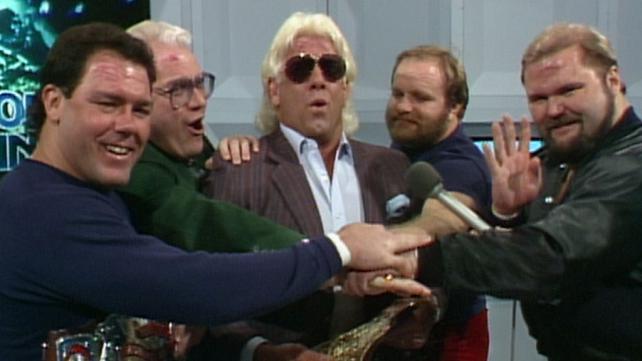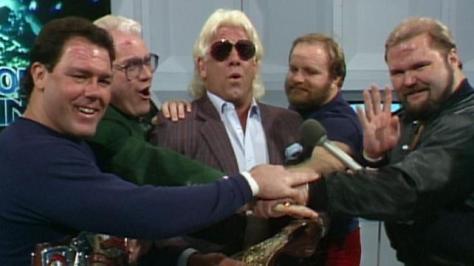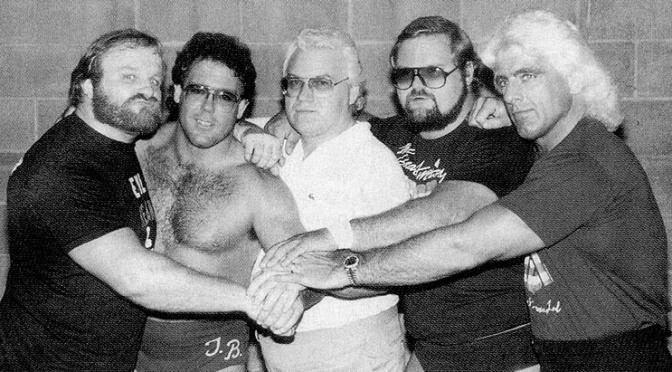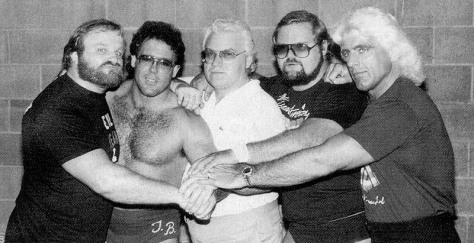It’s the Final Day of #4HorsemenWeek. In celebration of this month’s Survivor Series, we’re taking a look at famous stables from the wonderful world of wrestling. This is the thirteenth installment in our patent-pending Juice Make Sugar Wrestler of the Week series. As always we started by making The Horsemen a Stable You (Should) Probably Know Better. Tuesday, we gave you the finer points of their oeuvre with some Essential Viewing. Today, in addition to filling in the blanks from the past two days (Happy Thanksgiving!) we have an actual Difference of Opinion (and not, as suspected, a celebration of the Horsemen’s specific brand of awesome.)
Dave: Hey, Bray. *Brah Damn you autocorrect.
Nick: Bray is fine. My nickname in high school (not the one I gave myself, The Nickster) was Dr. Cornelius. So being called a fat guy from Florida isn’t that bad.
Dave: Wow. That’s a cross-generational burn right there. I’m impressed anybody we went to high school with was even aware of Planet of the Apes. (Outside of the Simpsons Dr. Zaius joke)
Nick: Charlton Heston is an American icon. And people love talking animals.
Dave: Truth.
Nick: And there are no greater American icons than the Four Horsemen.
Dave: If you’re talking 1980s wrestling, are The Horsemen collectively as big as Hogan?
Nick: I think in the wrestling fan zeitgeist, yes. In the zeitgeist zeitgeist? Not so much. I blame Notre Dame more for that, though. Or God.
Dave: I think in terms of being an act on top of a promotion, they were better than Hogan, but as you say, in terms of empire-building cultural icons, they’re not close to him. It’s a funny comparison to start making (which is why I made it right away).
Nick: Well, when you have something like the Horsemen, you don’t compare it to Oregon or LSU, you compare it to Bear Bryant. They are oddly timeless in a way because they are just hyper indicative of a specific era in time. They weirdly remind me of the Road Warriors in that way.
Dave: Oh yeah, nothing’s more 80s than The Horsemen. Private jets? Check. Conspicuous consumption? Check. Cocaine. Check.
Nick: I actually don’t think they checked the cocaine, David. I think they brought that directly on the private jet.
Dave: *Rimshot*
Nick: But when talking about their greatness, are we talking about the original team (give or take an Anderson) or the entire “franchise”?
Dave: It’s funny you bring that up because it’s a dilemma I was having all week. I think when you say “The Four Horsemen,” people think of Arn, Ole, Tully, Flair, and J.J. Dillon. And that lineup was undeniably great. But, honestly, it’s not even fun to talk about Lex Luger or Barry Windham or Steve freaking McMichael being Horsemen. The second the group stopped being something organically awesome and started being a brand to get over guys and angles, it lost a lot of its mystique.
Nick: To the level that the nWo did? Or was this more of a Corporate Ministry “this is a little contrived” situation?
Dave: If anything, I’d compare it to The Corporation, in that today’s “The Authority” is still basically The Corporation in it’s 10th incarnation.Some incarnations have been very good (The original, The “McMahon-Helmsley Regime”) and others have been bad (Austin Loves Vince, Anything involving Linda)…
Nick: Ignoring the heights, then, is there any “franchise” that is on the Four Horsemen’s level?
Dave: No, I don’t think anything’s even close. Look at Arn Anderson, he’s an awesome tough guy midcard wrestler, but because he was a member of The Four Horsemen, he’s this pantheon star. Even failed Horsemen like Paul Roma’s names will be remembered forever because they were Horsemen.
Nick: And you’re saying people don’t say the same things about The Mean Street Posse?
Dave: I’ll say this: Pete Gas sounds like something you get after eating spoiled vegetarian food.
Nick: *Rimshot* I know we talked about this “off air”, but what about The Shield?
Dave: If I could groan through the computer screen here, I would. Look, The Shield are talented guys, and they are over, but they are not even on the same planet as The Four Horsemen.
Nick: How so?
Dave: Well, for one, The Shield are lackeys. They do other people’s dirty work. Not only were The Horsemen not lackeys, they didn’t want lackeys of their own. They were all about handling business “like men,” to use the jargon of the time. Also, and I touched on this in Monday’s A Stable You Should Probably Know Better, The Four Horsemen brought prestige and a “must-see” feel to all the titles they held. And, honestly, I’m digging down deep to find more forgettable title reigns than The Shield have had.
Nick: The Shield definitely did that with the Tag Team belts.
Dave: See, I completely disagree. They dropped them to the right team (The Rhodeses), but I thought their title reign was boring. There’s a difference to being serious title holders and just standing there with the belts on your shoulder to “raise your profile.” To me, it felt like they were just standing there with the belts.
Nick: The crowd seemed to vehemently disagree.
Dave: Right, but as I said before, their heat has largely been an extension of being lackeys for people like Heyman and the Authority, so it wasn’t really even all their heat.
Nick: Isn’t that, as you’ll touch on today, a function of the era, though? They had to bring in them as Heyman’s mercenaries (which is what they’ve been “branded” as, at the very least) and the reason the belt profile wasn’t raised is because no one raises the belt’s profile no one can raise a belt’s profile anymore.
Dave: Well, I think there are “generational differences” as you point out (such as the prestige/portrayal of all non-top champions), but if we were doing the “lick your finger and stick it in the air” test, I think it would be pretty foolhardy to say The Shield were nearly as over as The Horsemen. Could The Shield carry the WWE for three years?
Nick: Well, they’ve only been around for a year, and there’s acceleration now because of the amount of content that comes out, but they’ve been the “Big Dogs in the Yard” for nearly entirety of the last year.
Dave: See, I think we’re hitting on a major problem that emerges when you’re talking about wrestling. They’re *booked* to be the “Big Dogs in the Yard,” but do they actually cause you to suspend disbelief and buy into that? In spite of their great matches with Daniel Bryan, did they ever seen like a threat to him? Would you be scared for John Cena if he crossed paths with them? I think they’re booked to feel like The Four Horsemen, but I think the final presentation falls well short of Horsemen-calibur.
Nick: Yes? I mean, I do. Reigns just destroyed the guy who they call The Best in the World. And won a Survivor Series match by himself. I think what I am saying is that if you don’t think the Shield are on the same planet as The Horsemen. Then you’d pretty much have to believe that nothing will ever be. Is that how you feel?
Dave: I think the original line-up of the nWo (Hall, Nash, Syxx, and Hogan) was close… I think the Triple H, Road Dogg, X-Pac, Billy Gunn version of DX was sort of close also… But in the final analysis, I think The Four Horsemen are just their own deal. Everything that came afterwards is inherently a cheap imitation.
Nick: Even the other Horsemen.
Dave: Exactly.






